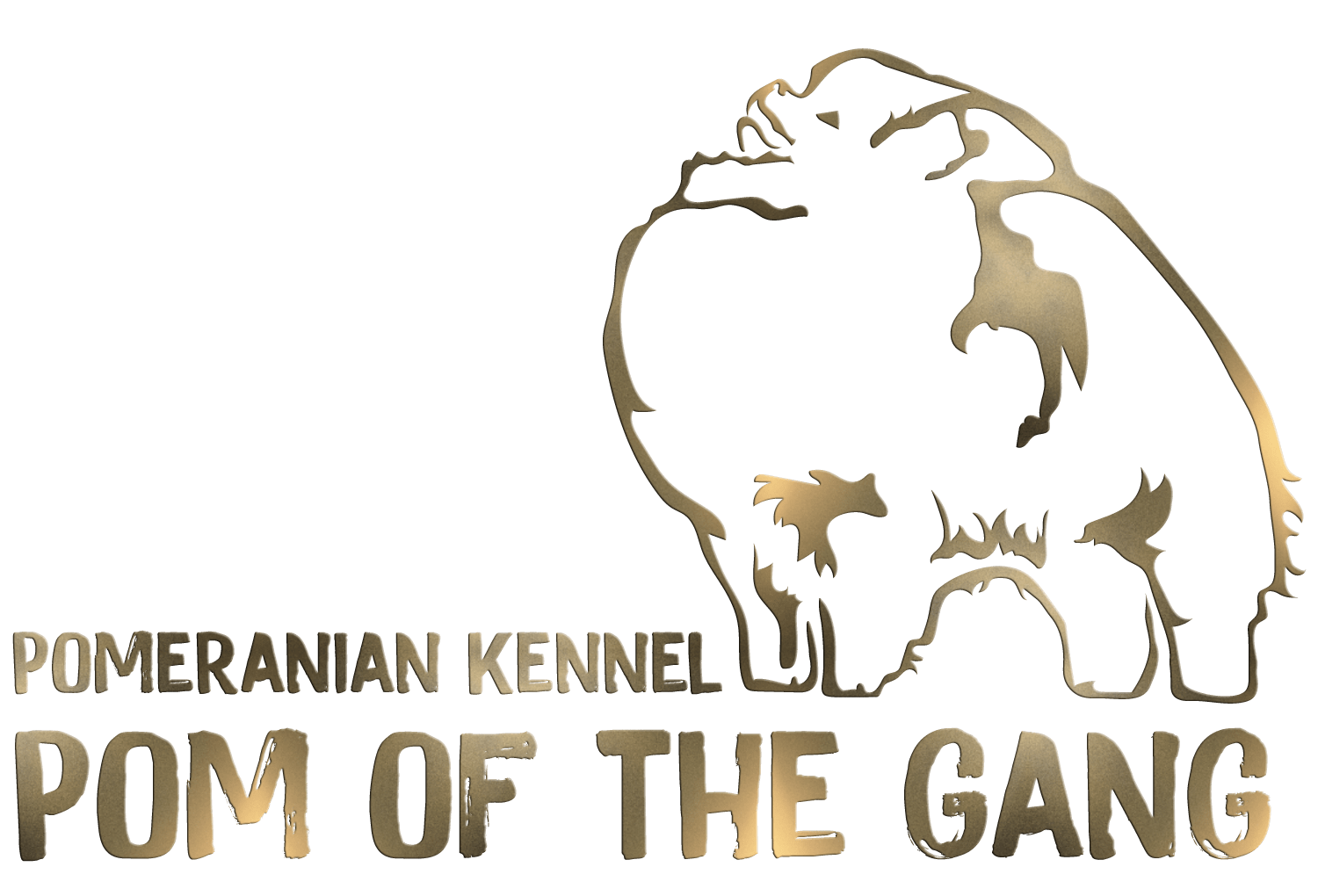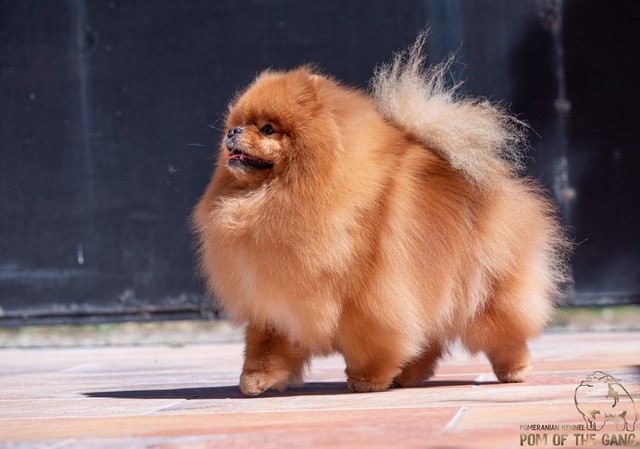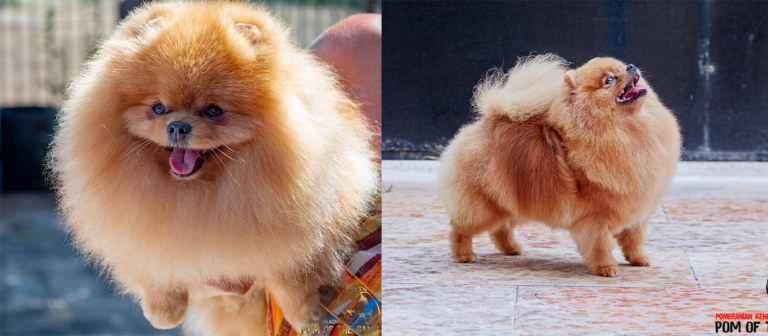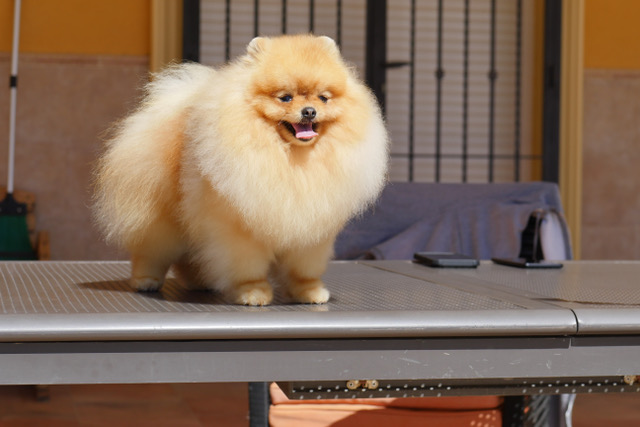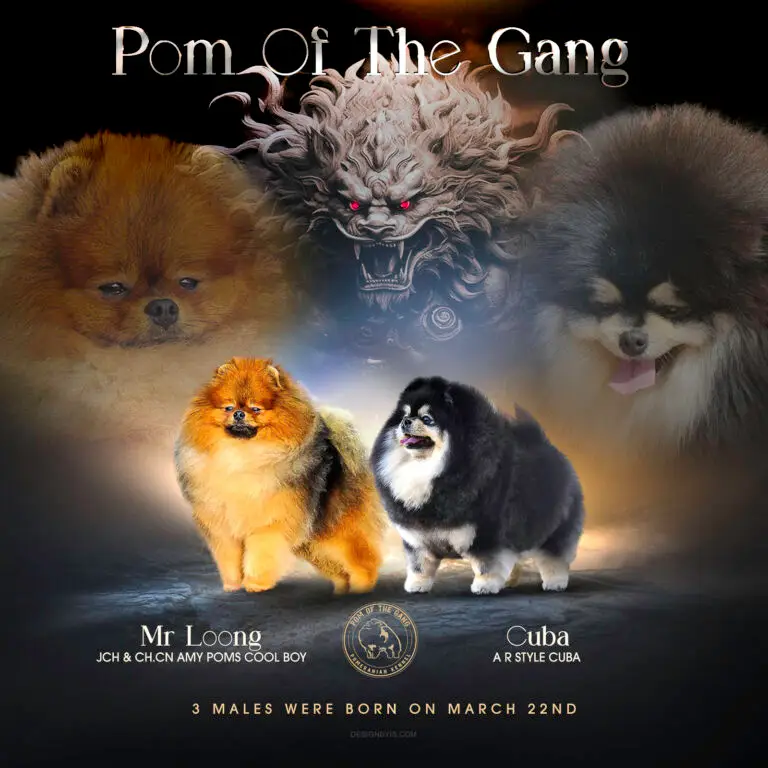“Pom”, “Teddy”, “Fox”, “Teddy bear”, “Baby-Doll”, “Tea cup”: why are these inappropriate terms to define types?
When you browse the internet looking for a Miniature Spitz, you may be confronted with a variety of names such as: "Pom", "Teddy", "Teddy Bear", "Fox", "Baby-Doll" and " Tea Cup.” These nicknames to define a type seem to make sense to many, yet they do not exist in the official lexicon of the breed!!
To define the different types in the Miniature Spitz, we should rather use the term bloodlines. But let's stay in the caricature of this photo below to better clarify the point.
- German Lineage (Fox)
- English Lineage (Mouse)
- North American lineage – US and Canadian – (Teddy Bear, Teddy Bear).
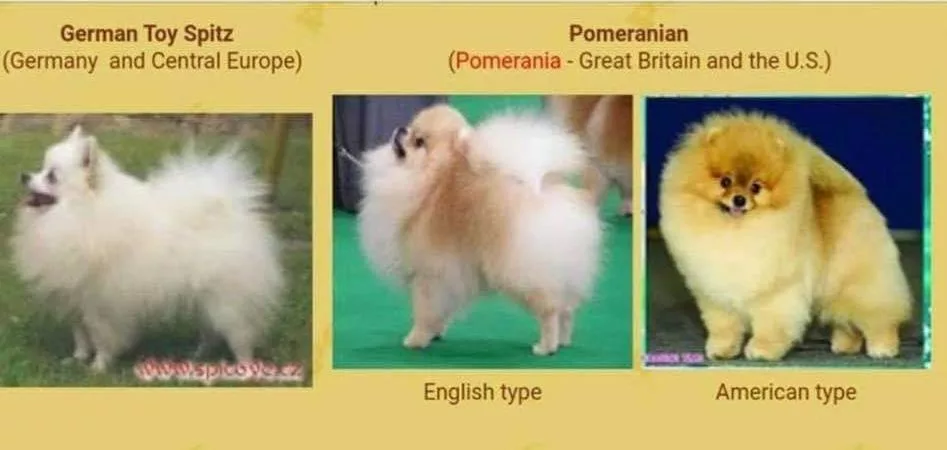
First of all, we will explore the origin and evolution of the Miniature Spitz, but also give an explanation of these different types.
We will end this article with our overall vision, which, of course, is ours alone.
History and Evolution of the Miniature Spitz: From Origins to Today:
The Dwarf Spitz, or Pomeranian, is recognized worldwide, but has various names: 'Pomeranian' in English, 'Zwergspitz' in German, 'Loulou de Poméranie', 'Pomeranien' or 'Dwarf Spitz' in France. While in the general public, 'Pom' is often used to refer to the 'teddy' type
The origins :
The origins of the Miniature Spitz, also known as the Pomeranian, can be traced back to Spitz-type dogs native to the Arctic regions of Northern Europe. Historical evidence dating back to 400 BC. BC attest to the existence of these robust and resistant ancestors, used for demanding tasks such as pulling sleds, guarding houses and protecting livestock.
Over time, they were called by several other names: Fox Dog, Lulu, Pommer, Wolfsspitz, German Spitz, Volpino and Spitz Dog.
From Pomerania to the English Nobility:
The breed gets its name from Pomerania, a region between modern Poland and Germany. Initially larger in size, these dogs were gradually bred to become smaller companions, a transition influenced by their adoption by English royalty in the 18th century.
The Introduction to England by Queen Charlotte:
In 1761, Queen Charlotte, wife of King George III, introduced her pet dogs to England, marking the beginning of the history of Miniature Spitz dogs in the country. These early specimens were larger, weighing between 14 and 23 kg, and were mainly white in color. At that time the breed was known as the 'Pomeranian'.
The Influence of Queen Victoria:
Queen Charlotte's granddaughter, Queen Victoria, was instrumental in the evolution of the breed. In 1888, she imported her first Miniature Spitz and acquired Italian Spitz in Florence, contributing to the diversification of the breed's colors and the reduction of its size. Under her influence, the breed grew in popularity, and she was involved in the creation of breed standards and the organization of dog shows.
Literature and Art: Witnesses to History:
The first known mention of a Miniature Spitz in British literature dates from November 2, 1764, when James Boswell mentioned the breed in his Grand Tour of Germany. This period also saw the Miniature Spitz featured in high society artwork, testament to their prestigious status.
The British Kennel Club:
Founded in 1873, the British Kennel Club officially recognized the name " Pomeranian " as a breed. This recognition helped establish breed standards and promote responsible breeding. At that time, the first Pomeranianweighed around 8 kg!
Introduction to North America:
At the turn of the 20th century, imported from England, Pomeranianappeared in the United States and Canada. Official recognition of the breed by the American Kennel Club (AKC) and the Canadian Kennel Club (CCC) in 1900.
In 1909, the APC (American Pomeranian Club) was accepted as a member club of the AKC and became the designated parent club of the breed. The PCA held its first specialty show in 1911 with 262 Pomeranianparticipating. The first Best of Breed winner was Ch. Banner Prince Charming.
Over time, North American breeders worked to adapt the breed to local preferences, resulting in variation in the breed standard. The famous “Teddy Bear” type is the type that is most successful with a wide audience. Small reminder: round ears do not exist! It is the cut of the hair which gives this rounding.
The Fédération Cynologique Internationale (FCI); late recognition:
Founded in 1911, the FCI, based in Belgium, coordinates breed standards between member countries. For the Pomeranian, the country of patronage according to the FCI is Germany, which means that Germany is responsible for defining the official breed standard that the FCI uses as a reference. This does not mean that Germany "owns" the breed, but rather that it has been recognized by the FCI as the reference country for the standard of this particular breed. Note the late recognition of the Miniature Spitz in Germany around 1970 within the VDH.
According to the FCI, the German Spitz comes in five varieties:
Wolf Spitz,
Great Spitz,
Middle Spitz,
Little Spitz,
Miniature Spitz (Pomeranian).
Countries affiliated with the FCI, such as France with the Société Centrale Canine, have aligned themselves with this classification, considering the Miniature Spitz as a variety of the German Spitz and not as a breed in its own right as in the USA or UK. National breed clubs may have slight variations in the breed standard, but these variations are generally minor and all tend to follow the guidelines established by the FCI for international competitions and evaluations.
Differences according to FCI, AKC, CKC, KC Standards:
pomeranian AKC) and Canadian Kennel Club (CCC ) : https://www.akc.org/dog-breeds/pomeranian/
- Weight: 1.36 to 3.18 kg (3 to 7 pounds)
Club (KC) pomeranian : https://www.thekennelclub.org.uk/breed-standards/toy/pomeranian/
- Weight: Males: 1.8 to 2 kilograms (4 to 4.5 pounds)
- Females: 2 to 2.5 kilograms (4.5 to 5.5 pounds)
Fédération Cynologique Internationale (FCI). https://pomofthegang.com/standard-fci-du-spitz-allemand-nain-pomeranien/
- Size: 18-24cm
These slight differences naturally have repercussions on the work of the farms.
We note in several American works that the average size of US Poms varies between 8-11 inches (20-28 cm)
In fact, for breeders affiliated with the FCI working with US lines, it is not uncommon to sometimes produce dogs exceeding the 24 cm imposed by the FCI.
The North American, English, German lines: the types of the Miniature Spitz.
A dog breed does not remain fixed; it evolves over time depending on the work of breeders on selection. We have seen that the Pomeranian Loulou migrated to England then North America. Public tastes depending on the country have had an impact on the orientation of breeders. Over time, this work of selection by breeders does its work constantly.
This explains why, depending on these lineages, there are different types in the Pomeranian.
We would like to point out that our findings, given here, are our own; some may have a different vision of things.
1/ First of all, we see a neglect of the German type (fox), perhaps too primitive in the eyes of the public.
2/ Let's be honest, the English type (mouse) suffered a lot from preconceived ideas about its finer bones and less abundant undercoat. Things are changing, especially for the security it provides to the coat.
3/ The North American type (teddy bear) remains the favorite of a wide audience. Its teddy bear side, its frame, its fur melt hearts. Its great popularity stands out from other types of the dwarf spitz. Unfortunately, for us breeders, things are not that simple.
We researched a lot of reputable breeders:
We have been very interested in this aspect of bloodlines in the breed. Thanks to social networks and our mastery of four languages, we have been able to create links with the world's largest breeders, international judges specializing in the breed and presidents of Pomeranianclubs. To name a few: Mr Tony Cabrera; (great US breeder and creator of “Starfire's” cosmetic products), Mr Fredrik Nilsson: (winner of the Cruft, World Champion, international judge specializing in Pomeranian and President of the Swedish Kennel Club) . Mr Geno Sisneros (AKC Judge, President of the American Kennel Club) and so many breeders such as Toby Tokie Multi Ch du monde or Miss Nantawan from Moxiepom without forgetting our friend Kod, and so many others, like Basilio Yap (Canton Pomeranians) with whom we exchanged a lot via Messenger and who runs a very interesting Blog that I recommend to everyone...
We traveled to several continents to get to know them better and thus appreciate their visions. Some, with their 40 years of experience, even the experience of several family generations, have taught us a lot of things about the evolution of the breed. It was very interesting to compare their work on the different types of Miniature Spitz. We cannot mention them all for fear of forgetting some, but we would like to thank them here.






Let's share what they taught us here:
They introduced us to different approaches and warnings on the main health problems of the Pomeranian , particularly those concerning the hair on the North American lines (Alopecia X or BSD). For the moment, in the absence of scientific certainty, everyone speculates according to their own observations, and breeding orientations differ.
Faced with this, some purists completely dismiss the US bloodlines, others mix the US and English bloodlines, while still others focus solely on the American.
We plan to write a detailed article on BSD, a complex subject, marked by many scientific uncertainties and random remedies. Looking forward to science providing a more enlightened vision to help us make the right choices.
We also note that the Russians worked almost exclusively on US and Canadian lines, and due to its proximity Russia supplied many puppies to Europe.
On the other hand, Northern European countries, aware of the problems linked to the hair quality of exclusively American lines, have opted for the integration of English lines through mixed crosses.
On the Asian continent, many US lines, but certain countries such as Japan are particularly fond of English lines.
However, we also see that on the North American continent, some breeders also work with English lines, ready to sacrifice a little their characteristic type.
Types of the dwarf spitz in the near future?
In the not-so-distant future, we may be able to offer this new table of types (photo). One thing is certain, many breeders with whom we speak work there.
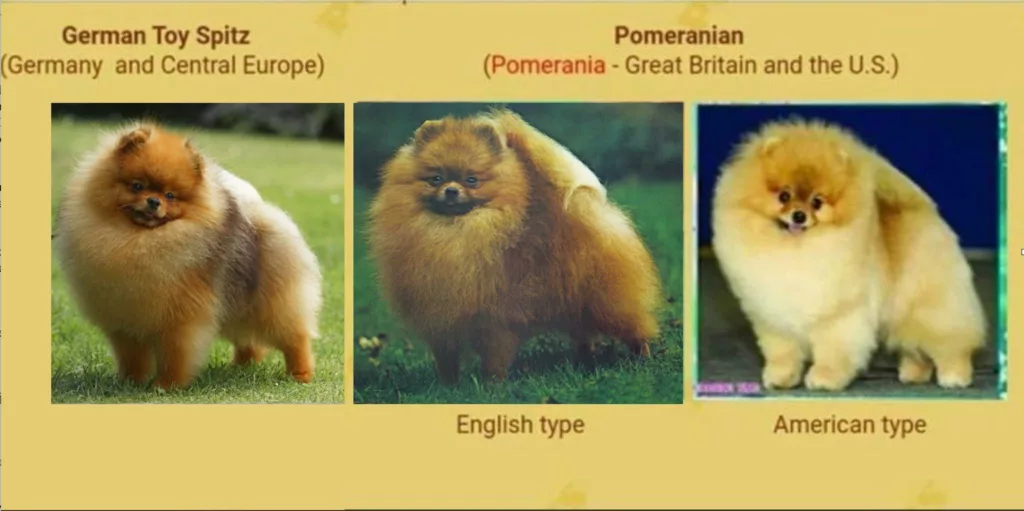
Our conclusion:
Each breeder works his lines to arrive at a type that he likes, by accentuating this or that physical aspect; there can therefore be notable physical differences within the same type.
Many responsible breeders are driven to produce the healthiest dogs possible, even if it means compromising on type. Others, we know, will make another choice. However, we are not here to judge anyone.
No breeder is immune to Alopecia X, we believe that we should all guide our selections by taking this genetic disease into account and working with healthy hair.
Breeding the Pomeranian provides immense satisfaction but also its share of disappointments. As far as we are concerned, we experience immeasurable pleasure in exchanging, every day, with other breeders from all over the world. What incredible richness the experiences of each of them bring us!
We hope that this article has offered a useful overview of the different lines of Pomeranianand their implications in breeding.
See you soon for a next article. Follow us on our FB page: https://www.facebook.com/SpitzNain. Pomeranian .PomOfTheGang/
